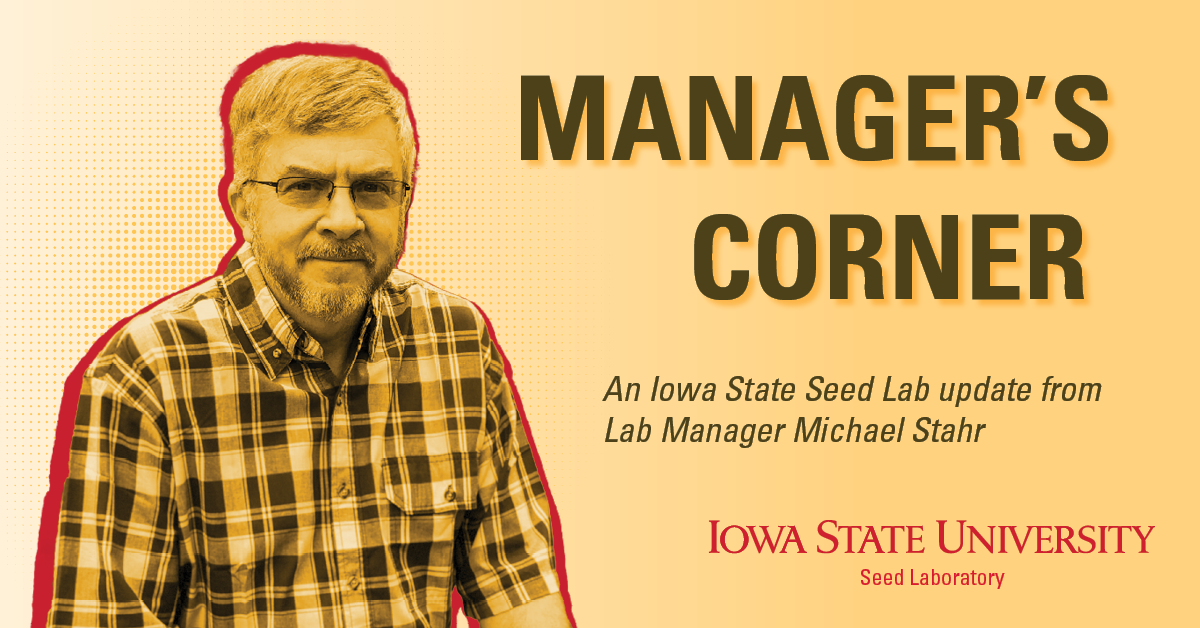Seed producers and farmers in southern Iowa struggling through dry conditions this summer probably never dreamed they would be dealing with weeks of rain this fall. If you live in the Midwest you are undoubtedly accustomed to swings in temperature and precipitation, but it is probably safe to assume you haven’t experienced a fall like this one.
Iowa experienced a wet spring, followed by a dry July and a resurgence of rain in August and September. Wet conditions are conducive to fungi growth, especially in cereals and soybeans. Farmers planning to plant rye seed they harvested as cover crops in their fields were likely shocked with warm germination test results required by NRCS and for farmers wishing to sell cereal seed to their neighbors. In general, seeds looked good, but germination test results in the 40-70 percent range were not unusual.
New crop soybean seed has been arriving at the Iowa State University Seed Testing Laboratory and it looks like it could be a tough year for soybean seed quality. Foggy, rainy weather this fall facilitated Phomopsis to spread from pods to seeds. Wet weather encourages spores within overwintering structures known as pycnidia to germinate and move to seeds. October’s wet weather with occasional dry periods will also likely lead to cracking of seed coats, increasing amounts of fungi, and possibly to pods shattering before or during combining.
The best bet for producers is to have a warm germination test conducted on bin run seed. Running this test will help producers know if seed quality has dropped and if there is a problem with fungi. Although a fungal screen using blotters or agar plates conducted by a seed pathology lab is the most accurate way of identifying the presence of fungi and determining the level of infection, the germination test can also provide useful information.
Based on the bin run results, conditioning seed can significantly improve quality. According to Alan Gaul, seed conditioning specialist at the Iowa State University Seed Science Center, useful cleaning equipment for conditioning soybean seed include an air screen cleaner, spiral or belt separators, gravity table, and color sorter. Although color sorters have gained wide acceptance, the most significant improvement will often come from increasing the air during post-aspiration, using a spiral separator or gravity table, and finishing with a color sorter.
A viable option in most cases is to treat the seed. The effectiveness of treatment will depend on the severity of fungal damage. Seed treatments have proven effective, but reach their limit when seeds are damaged to the point of no return. Some seed labs custom treat seeds upon request. When germs are unexpectedly low, it might save time and money for a seed company or farmer to have a lab treat seeds from a seed sample and then conduct another test. If the producer treats the seed lot because of the success of the custom treating of the seed sample, then another germination test must be done on the finished product. If seed treatment isn’t an option due to seeds being organic, then germination results may be improved by planting in sand or in rolled paper towels rather than using creped cellulose paper (i.e. Versapak TM). Seedlings growing in sand or towels have the advantage of friction removing seed coats. Seed coats can have fungi present, while the seed itself does not.
The Iowa State University Seed Lab offers many services and educational experiences to help you maintain the best health in your seed. For more information on improving seed quality through conditioning, contact Alan Gaul at agaul@iastate.edu. For information on fungal infection of seeds or testing low quality seeds contact the Seed Lab at 515-294-6826 or seedlab@iastate.edu.
Contact Mike Stahr at mgstahr@iastate.edu if you have questions about seed testing. If you have questions about reporting or the status of submitted samples, contact ISU Seed Lab Customer Care specialist, Cherie Hill, at seedlab@iastate.edu, or 515-294-6826.
—Mike Stahr, ISU Seed Lab Manager


